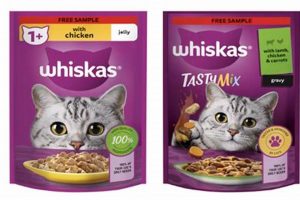Dishes suitable for individuals avoiding gluten are available at the Panda Express restaurant chain. These menu items are prepared without ingredients containing gluten, a protein found in wheat, barley, and rye. For example, certain grilled entrees, steamed vegetables, and sauces prepared with gluten-free alternatives may be viable options.
Catering to dietary restrictions such as gluten intolerance or celiac disease provides a wider range of choices for consumers. The inclusion of gluten-free options allows individuals with specific dietary needs to enjoy the restaurant’s offerings without adverse health effects. This consideration reflects a growing awareness and accommodation of diverse dietary requirements within the food service industry.
The following sections will detail specific menu items, potential cross-contamination concerns, and strategies for safely navigating the Panda Express menu while adhering to a gluten-free diet. Furthermore, the information aims to furnish consumers with the knowledge necessary to make informed dining decisions.
Successfully navigating the menu requires careful consideration of ingredients and preparation methods. The following recommendations offer guidance for minimizing the risk of gluten exposure.
Tip 1: Verify Ingredients. Prior to ordering, confirm the absence of gluten-containing ingredients with staff. Obtain specific ingredient lists for sauces and marinades to ensure suitability.
Tip 2: Inquire About Preparation. Determine if dedicated preparation surfaces and utensils are used for gluten-free items. Cross-contamination can occur if shared equipment is employed.
Tip 3: Focus on Grilled Options. Grilled chicken or steak, prepared without gluten-containing marinades or coatings, generally present lower risk.
Tip 4: Choose Plain Rice. Opt for plain steamed rice as a safer alternative to fried rice, which often contains soy sauce with wheat.
Tip 5: Exercise Caution with Sauces. Many sauces contain wheat-based thickeners or soy sauce. Request ingredient information or select oil and vinegar dressing when available.
Tip 6: Consider Steamed Vegetables. Plain steamed vegetables, prepared without sauces or seasonings, represent a relatively safe choice.
Tip 7: Remain Vigilant. Actively question the staff regarding any potential sources of gluten and convey the necessity of avoiding cross-contamination.
Adherence to these guidelines significantly reduces the potential for gluten exposure when dining at Panda Express. However, complete elimination of risk is not guaranteed.
The subsequent section will address frequently asked questions regarding the availability of gluten-free choices and offer additional resources for dietary management.
1. Ingredient Verification
Ingredient verification constitutes a critical step in determining the suitability of menu items at Panda Express for individuals adhering to a gluten-free diet. The presence of gluten-containing ingredients, even in seemingly innocuous dishes, renders them unsuitable for consumption by those with celiac disease or gluten sensitivity. A direct causal relationship exists: the presence of gluten-based ingredients directly negates a food’s classification as gluten-free. For instance, soy sauce, frequently utilized in Asian cuisine, often contains wheat; therefore, dishes incorporating standard soy sauce are rendered unsafe for gluten-free consumption. Without meticulous ingredient verification, unwitting exposure to gluten becomes highly probable.
The practical significance of ingredient verification extends beyond merely identifying obvious sources of gluten. Hidden sources, such as modified food starch or certain flavor enhancers, require careful scrutiny. Panda Express, like other fast-casual restaurants, may alter its recipes periodically. Consequently, past assurances regarding an item’s gluten-free status may become obsolete. A real-world example involves sauces: what was once a gluten-free sauce might be reformulated with a wheat-based thickener without explicit notification. Diligence in confirming ingredients with current staff and, if possible, referencing readily available online nutritional information, is paramount.
In summary, ingredient verification is not simply a precautionary measure but an essential safeguard for individuals requiring gluten-free food at Panda Express. The challenge lies in the potential for hidden gluten sources and recipe variations. By prioritizing this step, consumers can mitigate the risk of unintended gluten exposure, enabling more informed and safer dining choices. Failure to do so undermines the entire effort to maintain a gluten-free diet while dining at the establishment.
2. Preparation Methods
Preparation methods constitute a critical nexus influencing the availability and safety of gluten-free food at Panda Express. The procedures employed in the kitchen directly impact the potential for cross-contamination and, consequently, the suitability of menu items for individuals with gluten sensitivities or celiac disease. The following facets explore key aspects of preparation methods.
- Dedicated Cooking Surfaces
The utilization of dedicated cooking surfaces, separate from those used for preparing gluten-containing items, significantly mitigates the risk of cross-contamination. If a grill or wok is used for both items containing gluten and those intended to be gluten-free, residual gluten can transfer to the latter. For instance, if orange chicken, which contains a wheat-based breading, is cooked on the same surface as grilled chicken, the grilled chicken may become contaminated. Restaurants adhering to stringent gluten-free protocols often designate specific cooking zones solely for gluten-free preparations.
- Utensil Management
Utensil management parallels the importance of dedicated cooking surfaces. Shared utensils, such as spatulas, tongs, and serving spoons, can readily transmit gluten from one dish to another. Consider a scenario where a serving spoon used to scoop chow mein is then used to serve steamed vegetables. The vegetables, initially gluten-free, become contaminated. Effective protocols involve color-coded utensils or separate sets of utensils designated for gluten-free preparations only.
- Oil Usage
Shared frying oil presents a significant risk of cross-contamination. If oil is used to fry items containing gluten, such as egg rolls or crispy noodles, it will become infused with gluten particles. Consequently, any subsequent items fried in the same oil, even if inherently gluten-free, become unsuitable. Options like plain steamed items become preferable, as they bypass the risks associated with shared frying oil.
- Employee Training
Thorough employee training is paramount for implementing and maintaining safe preparation methods. Staff must be educated about the sources of gluten, the risks of cross-contamination, and the proper procedures for preparing gluten-free meals. This training should encompass proper hand-washing techniques, the correct usage of utensils, and an understanding of ingredient labels. Without adequately trained personnel, even the best protocols are vulnerable to human error, compromising the integrity of gluten-free offerings.
The interplay of these preparation methods determines the viability of obtaining truly gluten-free food at Panda Express. While some menu items may inherently lack gluten, inadequate preparation practices can easily introduce cross-contamination, rendering them unsuitable for those with dietary restrictions. The onus is on the restaurant to implement and maintain rigorous protocols, and on the consumer to inquire about these practices prior to ordering.
3. Cross-Contamination Risks
Cross-contamination poses a significant challenge to the availability of genuinely gluten-free food at Panda Express. It refers to the unintentional transfer of gluten from gluten-containing substances to food intended to be gluten-free. This phenomenon undermines even the most carefully selected menu items and represents a primary concern for individuals with celiac disease or gluten sensitivity.
- Shared Cooking Equipment
Shared cooking equipment, such as woks, grills, and frying oil, are primary vectors for cross-contamination. If these surfaces or mediums are used to prepare both gluten-containing and gluten-free dishes, gluten residue invariably transfers. For example, frying egg rolls (containing wheat) in the same oil subsequently used for a supposedly gluten-free entre contaminates that entre. The physical properties of gluten allow it to persist on surfaces despite cleaning efforts.
- Utensil Sharing
The use of shared utensils presents another avenue for gluten transfer. Spatulas, tongs, and serving spoons used interchangeably between gluten-containing and gluten-free items facilitate the migration of gluten particles. A scenario involves a serving spoon used to portion orange chicken then being used to serve steamed vegetables. Despite the vegetables being inherently gluten-free, they become contaminated due to the shared utensil.
- Airborne Gluten Particles
Airborne gluten particles, particularly in areas where flour is used, can settle on exposed food surfaces. The simple act of dusting or flouring can release minute gluten particles into the air, where they subsequently deposit on prepared or unprepared ingredients. This form of contamination is less controllable but still warrants consideration, especially in kitchens with inadequate ventilation or spatial separation.
- Inadequate Hand Hygiene
Insufficient hand hygiene practices among food preparation staff contribute significantly to cross-contamination risks. If employees handle gluten-containing ingredients and subsequently touch gluten-free items without thoroughly washing their hands, gluten will be transferred. This is particularly relevant during the assembly or plating of dishes, where direct contact with ingredients is common. Stringent hand-washing protocols are thus paramount.
The cumulative effect of these cross-contamination risks necessitates vigilant attention to detail to ensure the integrity of gluten-free food at Panda Express. While certain menu items may inherently lack gluten, the preparation environment and handling procedures ultimately determine their suitability for individuals with dietary restrictions. The establishment’s commitment to implementing and enforcing rigorous protocols is essential in mitigating these risks and providing genuinely safe options.
4. Sauce Composition
Sauce composition plays a crucial role in determining the suitability of menu items at Panda Express for individuals adhering to a gluten-free diet. Many sauces contain hidden sources of gluten, often in the form of thickening agents or soy sauce, which can render seemingly safe dishes unsuitable. Scrutinizing sauce ingredients and preparation methods is therefore essential.
- Thickening Agents
Many sauces rely on thickening agents to achieve the desired consistency and texture. Wheat flour or modified food starch derived from wheat are common choices. These ingredients introduce gluten into the sauce, making it unsafe for those with gluten sensitivities. A real-world example involves sweet and sour sauce, which frequently uses wheat-based thickeners. Therefore, confirming the absence of wheat-derived thickeners is crucial.
- Soy Sauce Content
Traditional soy sauce is typically brewed using wheat as a primary ingredient. Consequently, sauces incorporating standard soy sauce inherently contain gluten. In the context of Panda Express, sauces such as teriyaki sauce or stir-fry sauce often rely on soy sauce for their flavor base. Gluten-free alternatives, such as tamari (specifically labeled as gluten-free), can be used, but it is imperative to verify its presence in the specific sauce.
- Marinades and Coatings
Sauce composition extends beyond the final sauce itself to include marinades and coatings applied to proteins or vegetables. These preparations often contain gluten-based ingredients to enhance flavor or texture. A representative scenario includes meat marinated in a teriyaki-based sauce containing wheat or vegetables coated with a wheat-based batter before stir-frying. Examining marinade and coating ingredients is equally critical.
- Hidden Ingredients
Beyond obvious thickening agents and soy sauce, certain sauces may contain less apparent sources of gluten. Hydrolyzed vegetable protein (HVP), flavor enhancers, or even specific spices can be processed using gluten-containing materials. This underscores the necessity of a thorough review of all listed ingredients, as well as direct inquiry with restaurant staff regarding potential hidden sources of gluten. For instance, a sauce might contain a seemingly innocuous spice blend that includes wheat flour as an anti-caking agent.
In summation, sauce composition represents a pivotal consideration for identifying safe gluten-free food at Panda Express. From thickening agents to soy sauce and hidden ingredients, various components within sauces can introduce gluten. A meticulous approach involving ingredient verification, inquiry with staff, and a focus on sauces certified as gluten-free is vital for mitigating the risk of unintended gluten exposure when dining at this establishment.
5. Rice Selection
Rice selection at Panda Express significantly impacts the availability of gluten-free food choices. Certain rice preparations include ingredients containing gluten, while others offer a safe alternative for individuals with gluten sensitivities or celiac disease. A primary cause for concern arises from the addition of soy sauce, a common ingredient in fried rice preparations. Traditional soy sauce contains wheat, introducing gluten and rendering the dish unsuitable for gluten-free consumption. Conversely, plain steamed rice, prepared without soy sauce or other gluten-containing additives, presents a viable option.
The importance of rice selection is underscored by its frequent inclusion in meal combinations. Many entres are served alongside rice, making the choice of rice a crucial component of a gluten-free meal. For example, an individual may select a grilled chicken entre that is inherently gluten-free; however, if paired with fried rice, the entire meal becomes compromised. In this context, selecting plain steamed rice ensures the meal remains compliant with dietary restrictions. The practical significance lies in the ability to create complete, safe meal combinations by understanding the gluten content of different rice preparations.
In conclusion, rice selection represents a vital decision point when pursuing gluten-free food at Panda Express. The inclusion of soy sauce in fried rice necessitates a preference for plain steamed rice. This adjustment allows individuals to enjoy a wider range of otherwise gluten-free entres without the risk of unintended gluten exposure. Awareness of this connection enhances the ability to navigate the menu and make informed dining choices, aligning with the overarching goal of maintaining a gluten-free diet.
6. Vegetable Options
Vegetable options at Panda Express offer a potential pathway to gluten-free meal choices, contingent on preparation methods and ingredient selection. The inherent nature of most raw vegetables renders them gluten-free; however, sauces, seasonings, and cooking practices can introduce gluten, thereby negating their suitability for individuals with gluten sensitivities or celiac disease. A causal relationship exists: the addition of gluten-containing additives directly converts a naturally gluten-free vegetable dish into a gluten-containing one. For instance, steamed broccoli, naturally gluten-free, becomes unsuitable if tossed with a teriyaki sauce that contains wheat-based soy sauce. Therefore, the composition of any accompanying sauces or seasonings dictates the gluten-free status of vegetable dishes.
The selection of plain steamed vegetables, devoid of added sauces or seasonings, represents the safest approach for maintaining a gluten-free diet at Panda Express. Specific attention must be paid to potential cross-contamination during preparation. If steamed vegetables are prepared on the same surfaces or with the same utensils as gluten-containing items, the risk of gluten transfer is significant. An example involves using the same wok for cooking both stir-fried vegetables with soy sauce and plain steamed vegetables. In such a scenario, even the plain vegetables may become contaminated. The practical significance of this understanding lies in the necessity to inquire about preparation methods and request assurance that measures are taken to prevent cross-contamination.
In summary, while vegetable options at Panda Express offer a promising route to gluten-free meals, their suitability hinges on diligent attention to preparation methods and the composition of added sauces or seasonings. The selection of plain steamed vegetables, coupled with inquiries regarding cross-contamination prevention, represents the most prudent approach. Challenges remain in navigating potential hidden sources of gluten and ensuring consistent adherence to safe preparation practices. Prioritizing these factors allows individuals to make informed choices and enjoy vegetable dishes as part of a wider strategy for managing a gluten-free diet while dining at this establishment.
Frequently Asked Questions about Gluten Free Food at Panda Express
This section addresses common inquiries regarding the availability and safety of gluten-free options at Panda Express. It aims to provide clarity on menu choices and potential concerns for individuals with gluten sensitivities or celiac disease.
Question 1: Does Panda Express offer a comprehensive gluten-free menu?
Panda Express does not maintain a comprehensive, certified gluten-free menu. While certain individual items may inherently lack gluten, the potential for cross-contamination and the presence of gluten in many sauces and prepared dishes necessitates careful selection and inquiry.
Question 2: Which menu items are generally considered safer choices for individuals avoiding gluten?
Plain steamed rice, grilled chicken (without marinade), and steamed vegetables (without sauce) typically represent safer choices. However, the preparation methods must be verified to minimize the risk of cross-contamination.
Question 3: How can cross-contamination risks be minimized at Panda Express?
To minimize cross-contamination, it is advisable to request that food be prepared on clean surfaces with fresh utensils. Inquire about the use of shared cooking equipment, particularly woks and frying oil.
Question 4: Do the sauces at Panda Express contain gluten?
Many sauces at Panda Express contain gluten, often in the form of soy sauce (unless explicitly gluten-free tamari is used) or thickening agents. Specific ingredient lists should be reviewed, and staff should be consulted regarding gluten-free alternatives.
Question 5: Is it possible to request modifications to menu items to make them gluten-free?
While some modifications may be possible, the extent to which Panda Express can accommodate specific requests varies. It is important to clearly communicate dietary requirements and inquire about available options. However, absolute guarantees against cross-contamination may not be feasible.
Question 6: Where can reliable information regarding the gluten content of Panda Express menu items be found?
The most reliable information is obtained directly from Panda Express restaurant staff. Online nutritional information may not always be completely up-to-date or reflect local variations in preparation methods. Direct communication remains the most effective approach.
In summary, navigating the menu at Panda Express while adhering to a gluten-free diet requires diligence and proactive communication. While some options may be suitable, vigilance is crucial to minimize risks.
The following section will provide a summary of key considerations and recommendations for safely dining at Panda Express while avoiding gluten.
Conclusion
The preceding analysis clarifies the complexities surrounding gluten free food at Panda Express. While inherently gluten-free ingredients may exist within certain menu items, preparation methods and sauce compositions frequently introduce potential cross-contamination risks. Strict adherence to established guidelines, thorough ingredient verification, and direct communication with restaurant personnel are essential to minimize these risks.
Navigating dietary restrictions requires continuous vigilance and informed decision-making. Individuals seeking gluten free food at Panda Express must accept the inherent limitations and uncertainties associated with dining in a fast-casual environment. Prioritizing proactive inquiry and careful evaluation of available options remains paramount for safeguarding individual health and well-being.




![Best Gluten Free Fast Food French Fries [Guide + List] World’s Most Delicious Foods: Must-Try Dishes from Every Country Best Gluten Free Fast Food French Fries [Guide + List] | World’s Most Delicious Foods: Must-Try Dishes from Every Country](https://lisasfoods.com/wp-content/uploads/2025/12/th-787-300x200.jpg)


